Gerund and ParticipleWords are classified into various groups based on their use and purpose. These classifications are known as parts of speech. In English Grammar, there are eight parts of speech: These include nouns, pronouns, verbs, adverbs, adjectives, conjunctions, prepositions, and interjections. Today, we'll be discussing gerunds and participles. You're wondering exactly how those relate to the parts of speech, aren't you? To grasp these concepts, consider those two as alternative ways wherein the different elements of speech can be utilized. In other words, the major components of speech are your equipment, and our two topics today are the tasks for which you require the tools. 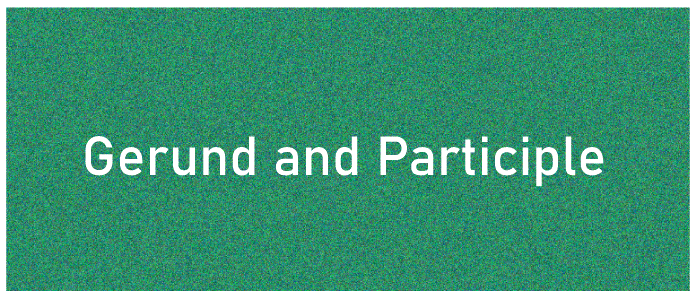
In English, verbs are classified into two types: finite and non-finite. When the quantity or person of the subject changes, finite verbs alter their forms. Finite verbs have various forms in distinct tenses as well. Non-finite verbs do not change their form when the subject's quantity or person shifts. Non-finite verbs are classified into three types: infinitives, gerunds, and participles. Gerund and ParticipleLet us have a look at Gerund first. What is a Gerund?A gerund is a term that is formed from a verb yet operates as a noun, and it always ends in -ing. When used as a noun, a gerund could be a subject, a subject complement, a direct object, an indirect object, or an object of a preposition. It is crucial to emphasize that while gerunds resemble present participles, these are not the same thing. Gerunds are used in the noun place of a sentence, but present participles are used along the verb phrase, that too as modifiers. 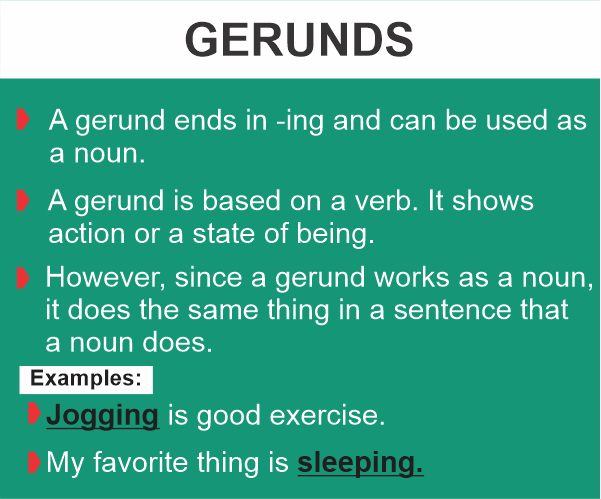
Examples of GerundsHere's an instance of a subject-position gerund : 1. Combing your hair keeps it from clumping. Combing is a gerund that serves as the sentence's subject in this statement. In a sentence, a gerund could serve as the complement of a subject and would look like this: 2. Her number one concern is cooperating. Cooperating serves as a supplement to the subject concern. Gerunds can also be used as sentence objects. Here's an example of a gerund acting as the object of a preposition: 3. "There is no use in waiting in a queue for 4 hours," the grandmother said. Standing comes after the preposition in this statement, leaving it as the object of the preposition. Now let us look at the Participles. 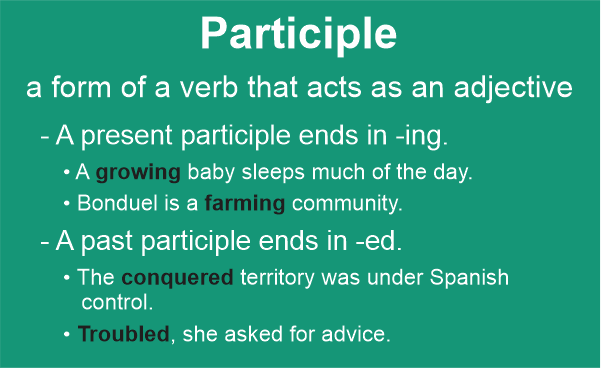
What are Participles?Participles are quite identical to gerunds. Participles are words that are formed from verbs and used as adjectives to alter nouns in a phrase. They can also be utilized to begin adverbial sentences. Present and past participles exist. Present participles usually finish in -ing and correspond to events in the present tense. The past participle can be regular or irregular, referring to events that have previously occurred. It might be difficult to distinguish between participles and gerunds at times since participles can also operate as gerunds. For our purposes today, we'll look at some easy situations. Examples of ParticiplesYou may come across a statement like this while employing a participle as an adjective: 1. The drying vegetable should be put out for composting. Drying is a present participle that modifies the word vegetable (notice the -ing ending). 2. I spent the entire day studying mathematics. In this statement, studying is a present participle that functions as the start of an adverbial phrase. The phrase studying mathematics modifies the verb spent. How did I spend my entire day? Studying mathematics. Both of those instances were present participles, which means the words finished in -ing to indicate something that was happening at the moment. Past participles, as previously mentioned, exist. The word ends of past participles might vary (based on the word being used). Most typically, -d or -ed will be appended to the end of a word. Consider the following examples: 3. The panes were ruptured when the thunderstorm came through. Ruptured is the past participle used as an adjective to alter the noun panes. 4. He proceeded forward, warned by the lonely streets. Warned is the sentence's past participle that serves as the start of an adverbial phrase that describes the word proceeded. Furthermore, participles can exist as multi-part verbs. The multi- comes from the addition of an auxiliary verb or helping verb to the primary verb in the sentence. 1. Mary was making homemade cookies for her grandchildren. was is a helping verb in the above sentence, whereas Making is the participle in the above sentence This combination results in a verb with many parts. 2. Joanna has been cooking all evening. has been is a helping verb in the above sentence and whereas Baking is a participle 3. Joanna would have been studying all afternoon if her grandchildren hadn't said they were hungry. would have been is the helping verb in the above sentence, whereas studying is the participle in the sentence. Knowing how to generate different participle endings enables a range of meanings to be expressed. What Is the Distinction Between a Gerund and a Present Participle?Both a gerund and a present participle are derived from a verb and end in -ing. Each, however, serves a distinct purpose. A gerund functions as a noun, but a present participle functions as a verb or adjective. Example: skating Skating is enjoyable! (Gerund) The athlete is currently skating. This is the present participle and verb. He was skating yesterday evening. This is the present participle and verb. 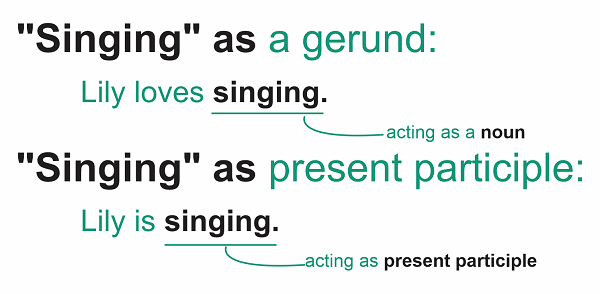
Example: thrilling A thrilling time was had by everyone. (Gerund ) The thrilling journey made the passengers scream. [adjective + noun] (the present participle ) Players liked the thrilling roller coaster. [adjective + noun] (the present participle ) The Ferris wheel is thrilling. This sentence has a present participle, be a verb, and an adjective. A present participle, unlike a gerund, can function as an adjective that changes a noun or accompanies the verb 'be.' Forms of Participle
Present ParticiplesThe present participle represents an action that is currently taking place or that is occurring at the same time or with or immediately preceding the action denoted by the main (or principal) verb, as in They're having breakfast now. (present progressive tense) Jean is writing an essay while Sandra is using the laptop (present progressive tense, implying that two events are occurring concurrently) Seeing the train coming, he rushed for the station.=As soon as/When/After he saw the train arriving, he ran for the train station. Babli came to see us, bringing her elder brother with her. ( In the above two sentences present participle, seeing, to show simultaneous action with that of rushed and came) Perfect ParticiplesThe perfect participle indicates an activity accomplished before the primary verb, for example. Having graduated from Oxford University , she began to study English in college. She began studying English after graduating from Oxford. (Perfect form to demonstrate preceding activity to that of began ) Having been married, they relocated to Nevada. (First married, then relocated ) Having been alerted of his dubious personality, I was ever on the wary in my dealing with him. After/When I was reminded of his skeptical personality... (Perfect form to demonstrate precedence to the action of was in the main clause ) Having seen the film, he wrote a review. He wrote a review on the movie after/when/as/because he saw it. (Perfect form to convey precedence to what was written in the main sentence) Present or Past ParticipleIn the finite form, the verb agrees with its grammatical subject in person and quantity and contains tense distinction, i.e. She studies/studied/can/will study Math. He is/was/has been/had been\studying Math. She was spotted in Las Vegas. I am/was present, etc. The following are some examples of participles found in finite verb formulations, such as
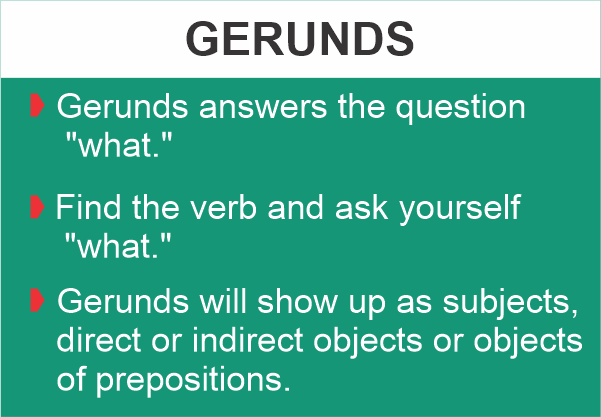
How Do You Tell Whether It's a Participle Or A Gerund?The simplest way to recognize the distinction between a gerund and a present participle is to seek for the assisting word "be." The present participle is identified by a form of "be" accompanied by the -ing form. For instance: They've been studying for 3 hours. The gerund occurs when the -ing form opens the phrase or follows a verb or preposition. For example: Playing basketball is a wonderful experience. Thus this concludes our lesson on Gerund and Participle.
Next TopicGerunds and Infinitives
| |||||||||||||||||||||||
 For Videos Join Our Youtube Channel: Join Now
For Videos Join Our Youtube Channel: Join Now
Feedback
- Send your Feedback to [email protected]
Help Others, Please Share









